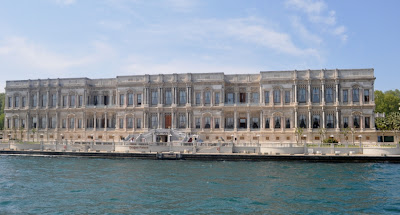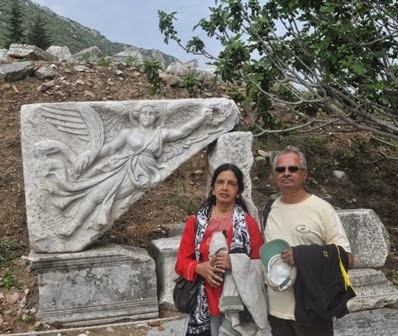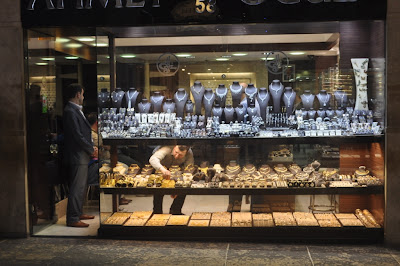TURKEY:
Turkey is a democratic, secular, unitary, constitutional republic with a
diverse cultural heritage. Turkey has become increasingly integrated with the West through
membership in various European organisations .Their application for joining the
European Union is pending since 1995.
Mustafa Kemal was the republic's first President and
introduced many
radical reforms with the
aim of transforming old Ottoman-Turkish state into a new secular republic. In
1934, the Turkish
Parliament bestowed upon Mustafa Kemal the
honorific surname "Atatürk" (Father of the Turks).He adopted
the Roman script for Turkish language, abolished the Fez cap and compulsory
wearing of burkha.
Turkey has openly supported Pakistan's
stance on the Kashmir conflict and
maintained political and military support during its wars with India. It has trained Pakistan pilots for
using the F16s given by the USA. Interestingly, Ex-President of Pakistan,
Pervez Musharaf grew up here and had extensive military training.
However Indians are welcome here and
we saw quite a few groups of Indians.
We landed in Istanbul around
10.30 am. Since the check-in time at the hotel was 2.00 pm we decided to have a
look at the Grand Bazaar. After check-in and lunch we visited the Hagia Sofia.
Next morning, we visited Topkapi
Palace, Sultan Ahmet Camii (the Blue Mosque) and the Hippodrome. After lunch, we went on a great cruise in the Bosphorus.
Late in the evening, we went to
SULTANA’S. It is a restaurant which presents a night of Turkish entertainment
with the most delicious mezes and dishes, the most talented belly dancers and folk
dancers as well as a HAREM SHOW depicting life in a harem. The belly dancer was
DIDEM said to be one of the best in the world with a huge following on face
book/you tube. It was a spectacular experience.
The most important point I
observed was the discipline of the traffic. People wait patiently for the
traffic to clear. Everyone sticks to his lane. No honking whatsoever, even
where roads are really narrow. The whole city is clean, no trash cans, plastic,or
tetra packs anywhere. Even inside the Grand bazaar, where there are chaotic
crowds, no one pushes. People are patient. Roads are excellent. There are
trams, Trolley buses (run on pneumatic tires but draw power from overhead
lines), and ordinary buses covering all parts of the city. Fares are quite low.
Generally, there does not seem to
be any criminal activity. However hotels suggest we leave valuables and
documents in their vaults.
Being a Muslim majority country,
it is quite difficult to get vegetarian food. You get only pizza, burger and salads. Breakfast at the
hotels is generally good, with a variety of breads, cereals and fruits. Eggplant
(brinjal) is a very popular vegetable and is used extensively.
Great variety of dry fruits are
available everywhere and are quite cheap compared to India. The most famous
sweets are the Baklava and Turkish Delight, made from corn flour, sugar, honey
and dry fruits. Simit is a circular
bread with sesame seeds and is a common breakfast item in Turkey.
This was probably the best season to
visit Turkey and Greece. The day temperatures were around 20 deg C going down
to 10 deg C in the nights. Days are long, giving sufficient time for the
visits.
About
Istanbul
Istanbul is the commercial and
cultural capital of turkey. The political capital is Ankara.
Istanbul:
Once known as the capital of capital
cities, Istanbul has many unique features. It is the only city in the world to
straddle two continents, and the only one to have been a capital during two
consecutive empires - Christian and Islamic. Once the capital of the Ottoman
Empire, Istanbul still remains the commercial, historical and cultural pulse of
Turkey, and its beauty lies in its ability to embrace its contradictions.
Ancient and modern, religious and secular, Asia and Europe all co-exist here.
Its variety is one of Istanbul’s greatest attractions: The ancient mosques,
palaces, museums and bazaars reflect its diverse history. The thriving shopping
area of Taksim buzzes with life and entertainment. And the serene beauty of the
Bosphorus, Princes Islands and parks bring a touch of peace to the otherwise
chaotic metropolis.
It’s
a peninsula bounded by bodies of water to north, east and south (the Golden
Horn, Bosphorus and the Sea of Marmara, respectively) and by the old city walls
to west, this part of the city is essentially what used to be called Constantinople, as the rest of
what is today Istanbul was part of independent cities, towns, villages, fields
or even complete wilderness later absorbed by the city. This process is still
going on as Istanbul grows with increasing speed.
Istanbul,
or Byzantium as it was called then, was first
settled by Greek colonists from Megara in Greek mainland in 667 BC. However, recent discoveries
in a metro construction site in Yenikapı (on the southern coast of the
peninsula) dates the very first date of Istanbul's settlement back to about
8000 years ago, which makes the city one of the oldest still-inhabited spots of
the world. This peninsula was declared a World
Heritage Site by UNESCO in 1985.
The most important places in Istanbul are
Topkapi Palace, Hagia Sofia, Sultan Ahmet Camii (the Blue Mosque), the
Hippodrome, Kapali Carsi (Covered Market/Grand Bazaar)) and the Museum of
Islamic Art.
SULTANAHMET SQUARE
Hagia Sophia :
Dating from the sixth century, it was originally a basilica constructed in 537 for the Eastern Roman Emperor Justinian I. A masterwork of Roman engineering, the huge 30 m diameter dome covers what was for over 1000 years the largest enclosed space in the world. It is considered as a masterpiece of Byzantine architecture The church was looted by the fourth Crusaders in 1204, and was converted into a mosque in 1453 by Sultan Mehmet II when the Ottomans conquered the city. It was converted into a museum in 1935 by Kemal Ataturk. There are excellent mosaics in the gallery, reached by a stone ramp to the left of the entrance.
Topkapı Palace
This was the imperial enclave of the
Ottoman emperors for four centuries. Lavishly decorated, with four courts of
increasing grandeur. In the second court are the Harem, the State Treasury
housing a weaponry display. The third court has the Imperial Treasury. Both
Islamic and Christian relics, rugs, porcelain are exhibited. The views from the
Fourth Court over the Bosphorus are spectacular. You can also see here some of Prophet
Mohammed's belongings.
Sultanahmet Mosque( Blue
Mosque)
Unique with its six minarets
and sweeping architecture the Sultanahmet or 'Blue' Mosque impresses from the
outside. Unlike Haghia Sophia, this is still a working mosque. The last great imperial mosque of the classical period, its
name comes from 20.000 marvellous blue-toned Iznik tiles decorating the
interior walls. It looks more grayish than blue.
Hippodrom
The Hippodrome of Constantinople was a circus that was the sporting and social centre of Constantinople, capital of the Byzantine
Empire. This is where chariot and
horse races were held. Constantine’s major undertaking was the renovation of
the Hippodrome. It is estimated that the Hippodrome of Constantine was about
450 m long and 130 m wide. Its stands were capable of holding 100,000
spectators. The race-track at the Hippodrome
was U-shaped.
This is adjacent to the Basilica
Cistern, Blue Mosque and Hagia Sophia.. The building no longer stands, but the
obelisks and sculptures that have been collected here since Theodosius' time in
the fourth century remain. It is said the four bronze horses in the facade of
St. Marco in Venice used to be on top of the Emperor's box in the Hippodrome
and they were looted by the crusaders in 1204.
Next to the hippodrome is the German Fountain a neo-Byzantine style fountain. It was a gift
sent by German Kaiser Wilhelm II to the Ottoman Sultan.
 |
| OBELISK |
 |
| PANEL ON OBELISK |
 |
| SNAKE COLUMN |
 |
| WALLED OBELISK |
Grand Bazaar
Istanbul's grand old bazaar
has an estimated 4400 shops lined along covered walkways. It is said to be the
world's oldest shopping mall, covers several blocks and features a labyrinth of
side streets to keep you lost for the better part of a day. The shops are
organized around their wares, e.g. the jewelers are clustered together, the
carpet shops are clustered elsewhere and the shoe shops are bunched together
somewhere else. The Bazaar now serves as an attraction for tourists (it seems
that most locals don't shop there) and you're likely to pay a little more for
your purchase than elsewhere but with the vast selection you'll find what
you're looking for and it's one of Istanbul's great attractions.
Bosphorus Cruise:
The Bosphorus strait connects the sea of Marmara to the
Black Sea and separates Europe and Asia, making Istanbul one of the most
beautiful cities in the world and the only one built astride two continents;
this romantic cruise along the Bosphorus allows you to admire the Dolmabahce Palace(Kemal
Ataturk breathed his last here and later converted into a museum ),
the Beylerbeyi Palace, the Ciragan Palace ( coverted into Kempinski Hotel)and
the Rumeli Fortress, ancient wooden villas, the Bosphorus and other bridges and
all the wonderful and unique maritime landscapes.
 |
| BEYLERBEYI PALACE |
 |
| BOSPHORUS BRIDGE |
 |
| CIRAGAN PLALCE |
 |
| DOLMAHCE PALACE |
 |
| MILITARY SCHOOL |
 |
| RUMELI FORTRESS 1 |
 |
| RUMELI FORTRESS 2 |
 |
| SEA SIDE VILLAS |
































No comments:
Post a Comment